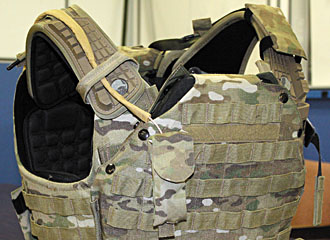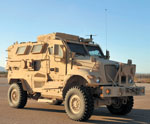Antenna Advances Counter Bombs and Improve Communications
 |
Scientists at the U.S. Army’s Communications-Electronics Research, Development and Engineering Center (CERDEC) are developing small antennas that can be built into solders’ equipment such as helmets and body armor. These devices promise to be lighter and less cumbersome than current whip antennas, and they provide better reception when troops are lying down or taking cover. These body antennas would equip troops with improved connectivity for their personal communications and battlefield computing systems. |
Researchers are pursuing advances in radio antenna technology to build communication equipment into body armor and to offer more capable and efficient methods for countering roadside bombs. Virtual modeling techniques incorporating developments in materials science currently are testing and verifying prototype equipment before physical testing begins. This combination of cutting-edge research and simulation has rapidly matured these antenna technologies and prepared them for initial operational evaluations.
Scientists at the U.S. Army’s Communications-Electronics Research, Development and Engineering Center (CERDEC), Fort Monmouth, New Jersey, have a number of ongoing efforts at varying stages of maturity, explains Jeffrey Hoppe, team lead, antenna technology team at CERDEC’s Space and Terrestrial Communications Directorate. Among these are the lightweight body wearable antenna (BWA) systems for individual infantry and the distributed antenna array (DAA) to protect vehicles from improvised explosive devices (IEDs).
BWA equipment ranges from helmet-mounted antennas to aerials built into the body armor and other equipment and clothing worn by soldiers. The most promising BWA technology consists of two small, flexible plate antennas designed to fit over the ballistic plates of soldiers’ body armor ensembles. A single cable routed over the wearer’s shoulder connects the antennas. This system, which now has transitioned to the Future Force Warrior Advanced Technology Demonstration program, provides a wideband capability to support soldier waveform radio communications capable of supporting voice, video and data transmissions. The differential plate design allows a 225-1,000 megahertz (MHz) bandwidth capability, which is twice the bandwidth of the whip antennas now in use, Hoppe says.
During demonstrations, testers communicated with the BWA successfully when soldiers were both standing and lying on the ground. Hoppe says that the BWA provides reception comparable to standard whip antennas when soldiers are standing. But the plate antennas, which are located on the front and back of a soldier’s body armor, have superior reception to whip antennas when soldiers are lying down. He explains that the BWA provides reliable communications for soldiers regardless of their position, and it also eliminates the long, cumbersome whip antennas and therefore reduces soldiers’ silhouettes and increases their survivability.
Hoppe’s team also is working on BWA systems for other programs. CERDEC is collaborating with the Defense Advanced Research Projects Agency on the Wireless Network After Next (SIGNAL Magazine, April 2008) program to test and evaluate the performance of a BWA. He explains that his group is conducting gain pattern testing, which measures an antenna’s ability to radiate and perform.
To measure the effects of radio frequency radiation on the human body, CERDEC researchers use mannequins filled with liquids and materials simulating a range of human tissue. The BWAs then are placed on the mannequins and tested for radiation performance. These tests have two purposes. The first goal is to determine how effective the antennas are in receiving and transmitting radio signals, and the second goal is to measure the safety of the antennas radiating in close proximity to the body.
Over the years, Hoppe says, CERDEC has conducted considerable research into BWA systems. He notes that tests have occurred on 10 different variations of helmet-wearable antennas and up to 13 types of BWAs. CERDEC researchers are developing antennas for a variety of Army programs such as Signal Warrior, which is an evolution of the Land Warrior program. Hoppe admits that many of the antennas under evaluation have not yet begun operational tests, but he adds that some of these systems now are beginning the transition.
CERDEC researchers have developed BWAs that can operate effectively in the ultra high frequency (UHF) range, but Hoppe notes that very high frequency (VHF) antennas remain a challenge. One obstacle for VHF BWAs is that they are larger than UHF systems. The VHF radio band ranges from 30 MHz to 300 MHz. He shares that the U.S. Army VHF systems primarily operate in the 30- to 90-MHz range.
Physics is another challenge for developing personal VHF antennas. Hoppe explains that the wavelength for VHF transmissions ranges from 10 meters to slightly under 5 meters. Efficient antennas are typically a quarter of the wavelength. “At the lowest end of the frequency band, at the 10-meter wavelength, you would need a two-and-a-half meter antenna in order to work efficiently,” he says. The drawback is that this traditional approach creates a very large and obvious aerial for infantry units. There is ongoing work to reduce the size of VHF antennas, but he notes that they remain a major technical challenge.
 |
 |
CERDEC scientists have developed a prototype jamming system that defends vehicles against improvised explosive devices without jamming friendly force communications. The distributed antenna array uses four directional antennas, one on each side of the vehicle, to beam focused jamming signals into the ground around it. The low-mounted antennas also prevent the jammer from interfering with roof-mounted communications systems. |
Hoque says that a helmet-mounted antenna tested in 2009 at
One material under consideration is fabric made of nanofibers, which are strong, lightweight and have excellent electrical conductivity. CERDEC is working with the U.S. Army Research Laboratory’s Weapons and Materials Research Directorate on these new materials. Hoque adds that his group also has interacted with the Massachusetts Institute of Technology’s (MIT’s) Lincoln Laboratories on this issue because the Army funds MIT for nanomaterial development, particularly nanofabrics. “That is our ultimate vision, to develop a very efficient fabrics approach. Right now what we have is pretty good,” he says.
Another promising area of research is CERDEC’s work on DAA technology to jam IEDs. Current IED jamming systems rely on a large stick antenna radiating a hemispherical jamming signal. While these systems have proved effective, they also have disrupted communications between coalition forces because the jammer antennas are in close proximity to communications antennas on the tops of military vehicles. Interference with friendly systems is a major issue for IED jammers. “You really would like to focus your energy toward the ground around the vehicle because that’s where the IED is,” Hoque says.
To develop the DAA, CERDEC scientists divided vehicles into four quadrants and placed a directional antenna on each side of the vehicle. Hoppe notes that because DAA is directional, it disperses energy down and away from the vehicle and creates a “quiet zone” on top of the vehicle for communications systems.
Another feature of DAA is that it is not obstructed. Hoppe explains that when whip antennas are placed on top of vehicles, their performance is degraded by protuberances such as gun turrets. These obstructions create a shadowing effect that can prevent IEDs from being jammed in the shadowed area. Current systems increase power output to overcome shadowing. Because it is not obstructed, the DAA allows more efficient jamming and avoids the need for vehicles to waste power to cover shadowed areas, he explains.
The DAA also uses circular polarization to enhance its jamming capability. Hoppe notes that IEDs often use whip antennas, which are polarized linearly. If the antenna is standing vertical, it is vertically polarized, and if it is horizontal, it is horizontally polarized. Circular polarization allows the system to jam the IED no matter how the weapon’s antenna is oriented. “Circular polarization is really the best of both worlds,” he says.
Hoppe adds that CERDEC engineers have solved many of the shadowing and other engineering issues associated with IED jamming systems. He shares that the DAA also has a much lower visual profile than previous jammers because it is conformal to the vehicle.
The DAA concept, from its inception to the development stage, was conducted in-house at CERDEC. Hoppe notes that CERDEC’s modeling and simulation group modeled the entire design before efforts began on the prototype.
CERDEC is working in conjunction with the U.S. Defense Department’s Joint IED Defeat Organization (JIEDDO) to overcome the IED challenge. JIEDDO funded the DAA program for two years. During that time, the CERDEC team held two successful demonstrations. Hoque notes that the effort is now mature. “We’re now thinking about how we can put it into the field,” he says.
A prototype DAA system will be tested in
WEB RESOURCES
CERDEC: www.cerdec.army.mil
MIT




Comments